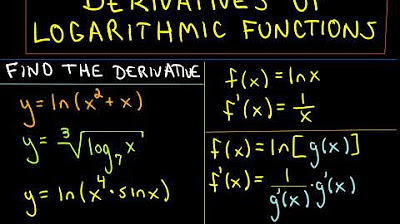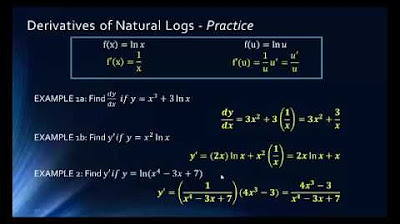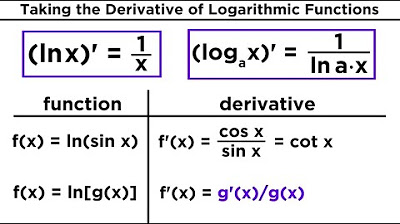Derivative of log_x (for any positive base aÃÂ1) | AP Calculus AB | Khan Academy
TLDRThis video script explains the concept of finding the derivative of a logarithm with an arbitrary base, using the natural logarithm as a foundation. It introduces the change of base formula, demonstrating its utility in converting logarithms between different bases, and shows how to apply this to the derivative of log base A of X, which is expressed as 1/(natural log of A) * 1/X. The explanation is clear and provides examples to help users understand the process, making it an engaging and informative resource for those interested in calculus and logarithms.
Takeaways
- 📚 The derivative of the natural log of X (ln(X)) with respect to X is 1/X.
- 🔄 The concept of changing the base of a logarithm is introduced, using the formula log base A of B = log base C of B / log base C of A.
- 📱 Calculators typically have a 'log' button for base 10 logarithms and a 'natural log' button for base e logarithms.
- 🌐 To find logarithms of other bases, one can utilize the change of base formula and properties of natural logs.
- 🤔 The derivative of a logarithm with a variable base can be found by rewriting the log as a natural log and applying the chain rule.
- 📈 The derivative of log base A of X (log_A(X)) is given by (1 / (ln(A) * X))
- 🌟 The natural log function's derivative (1/X) is fundamental in deriving the derivative of logarithms with arbitrary bases.
- 📌 Example given: If F(X) = log base 7 of X, then F'(X) = 1 / (ln(7) * X).
- ⏪ For a function with a constant coefficient, like G(X) = -3 * log base pi of X, the constant multiplies the derivative of the logarithm.
- 🔢 The derivative of G(X) = -3 * log base pi of X is -3 / (ln(pi) * X).
- 💡 This approach to derivatives of logarithmic functions provides a powerful tool for analyzing various mathematical and real-world problems.
Q & A
What is the derivative of the natural log of X with respect to X?
-The derivative of the natural log of X (ln(X)) with respect to X is 1/X.
How can you express the logarithm of an arbitrary base in terms of natural logarithms?
-You can express the logarithm of an arbitrary base (log base A of X) as the natural logarithm of X divided by the natural logarithm of A (ln(X) / ln(A)).
What is the change of base formula for logarithms?
-The change of base formula states that log base A of B can be rewritten as log base C of B divided by log base C of A.
How does the change of base formula apply to a calculator that uses base 10 logarithms by default?
-To find a logarithm in a different base using a calculator that uses base 10 (log) by default, you can input the log of the number you want to find the logarithm of, divided by the log of the base (e.g., log(8) / log(3) for log base 3 of 8).
What is the derivative of log base A of X with respect to X?
-The derivative of log base A of X with respect to X is (1 / (ln(A))) * (1 / X), where ln(A) is a constant and ln(X) is the natural logarithm of X.
How can you find the derivative of a logarithmic function with a different base if the base is not the natural logarithm base (e)?
-You can find the derivative by using the chain rule and the change of base formula, rewriting the logarithmic function in terms of natural logarithms and then differentiating with respect to X.
What is the relationship between the natural logarithm and the common logarithm?
-The natural logarithm (ln) is the logarithm with base e, while the common logarithm (log) has base 10. The natural logarithm of X is equal to the common logarithm of X multiplied by ln(10).
What is the derivative of a constant multiplied by a logarithmic function?
-The derivative of a constant (c) multiplied by a logarithmic function (log base A of X) is the constant divided by the logarithmic base (ln(A)) times the derivative of the argument of the logarithm (1/X).
How does the derivative of a logarithmic function change if there is a negative sign in front of the logarithm?
-If there is a negative sign in front of the logarithm, the derivative will also have a negative sign. The derivative will be -(1 / (ln(A))) * (1 / X).
What is the significance of the derivative of a logarithmic function in calculus?
-The derivative of a logarithmic function is significant in calculus as it allows us to analyze the rate of change of the function, which is crucial for optimization problems, understanding the behavior of functions, and solving related differential equations.
Can you use the derivative of a logarithmic function to find the critical points of a function?
-Yes, the derivative of a logarithmic function can be used to find the critical points of a function by setting the derivative equal to zero and solving for X, which will indicate potential maximum or minimum points of the original function.
Outlines
📚 Understanding Derivatives of Logarithmic Functions
This paragraph introduces the concept of finding the derivative with respect to X of a logarithm with an arbitrary base. It begins by referencing previous knowledge of the derivative of the natural log of X, which is 1/X. The voiceover explains the goal of the video is to extend this understanding to logarithms with different bases, denoted as log base A of X. The key concept introduced is the change of base formula, which allows the conversion of logarithms from one base to another. This is demonstrated using the formula log base C of B equals log base C of B divided by log base C of A. The paragraph emphasizes the practical application of this formula, especially when using a calculator that typically has buttons for log base 10 (log) and log base E (natural log). The video aims to show how to find derivatives of logarithmic functions with various bases by leveraging the known derivative of the natural log.
Mindmap
Keywords
💡derivative
💡natural log
💡logarithm
💡change of base
💡algebra
💡pre calculus
💡calculator
💡constant
💡rate of change
💡function
💡exponential growth
Highlights
The derivative with respect to X of the natural log of X is equal to 1 over X.
The goal is to find the derivative of a logarithm with an arbitrary base.
A change of base formula is introduced, which is key to understanding logarithms with different bases.
The change of base formula is log base C of B equals log base C of B divided by log base C of A.
Calculators have a log button for base 10 logarithms and a natural log button for base e logarithms.
To find logarithms with other bases, the change of base formula can be utilized.
The derivative of log base A of X can be rewritten using the natural log of X over the natural log of A.
The derivative of log base A of X simplifies to 1 over the natural log of A times the derivative of the natural log of X.
The derivative of the natural log of X is known to be 1 over X.
The derivative of log base A of X is thus 1 over the natural log of A times 1 over X.
The formula can be further simplified to 1 over the natural log of A times X.
The process demonstrated can be applied to find derivatives of logarithms with various bases.
An example is given where F of X is log base 7 of X, and its derivative is found using the derived formula.
For a function like G of X which is negative 3 times log base pi of X, the derivative is calculated by applying the formula.
The video provides a comprehensive understanding of logarithmic derivatives and how to calculate them.
The use of the natural log makes the process of finding derivatives of logarithms with arbitrary bases more accessible.
The video is a valuable resource for those looking to understand the mathematical principles behind logarithms and their derivatives.
Transcripts
Browse More Related Video

Derivatives of Logarithmic Functions - More Examples

How to Change the Base of a Logarithm (Precalculus - College Algebra 61)

Math1325 Lecture 11 1 Derivatives of Logarithm

Deriving Natural Logarithms!

Derivatives of Logarithmic and Exponential Functions

Logarithmic functions differentiation | Advanced derivatives | AP Calculus AB | Khan Academy
5.0 / 5 (0 votes)
Thanks for rating: